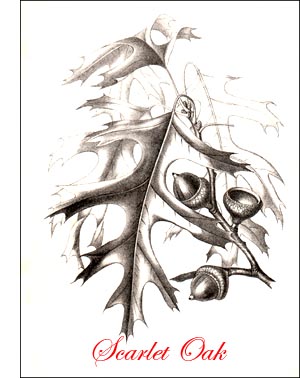Scarlet Oak Tree
 Scarlet Oak (Quercus coccinea, Muench.)-Slender, symmetrical tree, 70 to 160 feet high, with graceful, curving branches and twigs, tapering trunk and round head. Bark brown or grey, rough, scaly, shallowly fissured; inner layers reddish; twigs green, scurfy, becoming red and smooth. Wood pale brownish red, hard, coarse grained, strong, heavy, of rapid growth. Buds pointed, hairy at tip, small, reddish. Leaves oval or obovate, thin, smooth, shining above, paler beneath, sometimes hairy tufted on veins, 3 to 6 inches long, 2 to 5 inches broad, with 5 to 7 spreading bristly pointed and subdivided lobes, with deep, rounded sinuses between; autumn colour scarlet; petioles slender, long. Flowers staminate catkins slender, reddish before maturity; pistillate with long stigmas bright red. Acorns biennial, 1/2 to 3/4 inch long, half covered by short-stalked cup, smooth, triangular, close-pressed scales, rounding in at the top; kernel white, moderately bitter. Preferred habitat, dry, fertile loam. Distribution; Maine to Florida, west to Minnesota, Nebraska and Missouri. Best development in lower valley of Ohio River. Uses: A favourite ornamental oak in this country and in Europe. Lumber used for same purposes as that of Q. rubra.
Scarlet Oak (Quercus coccinea, Muench.)-Slender, symmetrical tree, 70 to 160 feet high, with graceful, curving branches and twigs, tapering trunk and round head. Bark brown or grey, rough, scaly, shallowly fissured; inner layers reddish; twigs green, scurfy, becoming red and smooth. Wood pale brownish red, hard, coarse grained, strong, heavy, of rapid growth. Buds pointed, hairy at tip, small, reddish. Leaves oval or obovate, thin, smooth, shining above, paler beneath, sometimes hairy tufted on veins, 3 to 6 inches long, 2 to 5 inches broad, with 5 to 7 spreading bristly pointed and subdivided lobes, with deep, rounded sinuses between; autumn colour scarlet; petioles slender, long. Flowers staminate catkins slender, reddish before maturity; pistillate with long stigmas bright red. Acorns biennial, 1/2 to 3/4 inch long, half covered by short-stalked cup, smooth, triangular, close-pressed scales, rounding in at the top; kernel white, moderately bitter. Preferred habitat, dry, fertile loam. Distribution; Maine to Florida, west to Minnesota, Nebraska and Missouri. Best development in lower valley of Ohio River. Uses: A favourite ornamental oak in this country and in Europe. Lumber used for same purposes as that of Q. rubra.The splendour of our autumnal forests owes much to the foliage of the scarlet oak. The tree blazes like a torch against the duller reds and browns in the woods, and often keeps its brilliancy until after snow covers the ground.
There is no reason for confusing the black, red and pin oaks with this species. They are all heavy and coarse beside it. Their leaves are leathery compared with the papery thinness of these. In summer the scarlet oak lifts its young shoots, delicately pink above the last year's growth, and waves them like long, tapering plumes, set with skeleton leaves. Break a twig, and the smoothness and delicacy of the leaves strike you. Just a pale trace of fuzziness remains along the veins on the under side. The wide, rounded sinuses are cut nearly to the midrib, and the leaf flutters airily on a long petiole. The acorn differs from the black oak's in having its cup drawn tightly in at the top.
Though we have planted this tree less often than the red oak and pin oak in this country, it is coming to be recognised as superior to both, while in hardiness and rapidity of growth it is the equal of either.
Scarlet Oak Tree picture